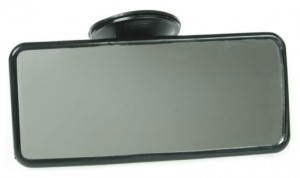Two different types of mirrors are available for driving lessons and driving tests. Blind spot mirrors attach or stick to both the existing wing mirrors and an extra internal mirror that is used during driving lessons and by the examiner for the driving test.
The blind spot mirror can aid in all round observation in general driving and during the driving test. The mirrors not only aid in safe driving, but can also assist during the driving test particularly during the manoeuvres.
Both mirror types are easy to fit and affordable and are explained in this section. Also explained in brief is the blind spot, what it is and what is required to avoid it.

Driving instructors / examiners interior mirror
An extra internal mirror used for rear observation for both the driving instructor and the examiner during the driving test. You should provide an additional internal rear view mirror for the examiner, however in our experience, if you forget to take one along, examiners usually carry a spare.
Internal mirrors are relatively cheap; anywhere from £5.00 to £10.00 and can be purchased from most car maintenance outlets such as Halfords. Fitting is simple by use of a suction cup. The extra interior mirror only has value during driving lessons and the driving test and has no use once the driving test has been passed.
Blind spot mirror
Blind spot mirrors come in either a stick-on version that sticks to the glass of your existing side mirrors or a screw on version such as the mirror in the image that attaches to the surrounding edge of your side mirrors.
Blind spot mirrors vary in price depending on size and quality. They cost anywhere from £5.00 to £15.00 and can be purchased from most car maintenance outlets such as Halfords.
Benefits of a blind spot mirror
In general driving, a blind spot mirror will provide better all-round observation, especially in difficult to see areas such as the blind spot. If you intend on changing lanes for example, blind spot mirrors aid in your ability for observing cyclists or motorbikes that are often difficult to see. They also provide a valuable source of observation when it comes to taking the driving test. Driving test manoeuvres involve reversing and it is of course difficult to see where you are going. Blind spot mirrors will aid observation in the:
- bay parking manoeuvre by reversing and staying between the bay lines. The blind spot mirror will provide a better view of the bay lines than your existing side mirrors.
- reverse round a corner by providing a clearer view of the kerb, ensuring you do not hit or stray too far from the kerb.
- reverse parallel parking by gaining better observation of the kerb as you are reversing towards it.
It is important to note however that by using a blind spot mirror is not a replacement of the usual observations. It’s essential that you still perform all round observation before moving off, including the blind spot. Failure to do this during the driving test will result in a test failure as described in the How to fail the driving test section.
The blind spot
The blue shaded areas are the blind spot of the red vehicle. The driver of the red car can see the orange car in the rear and right-side mirrors, but the yellow car is in the blind spot so cannot be seen in any mirrors.
A blind spot mirror will provide a wider degree of observation allowing the driver to locate the red car in the blind spot mirror. Even with a blind spot mirror, certain areas are still blind or difficult to see, so a physical observation is always needed before changing direction.
- See the blind spot guide for an explanation and diagrams.
Adjusting mirrors on driving test
This is something we get asked frequently. Yes you can adjust a wing mirror before a manoeuvre. If you intend on adjusting a mirror, ensure the car is stationary and secure before doing so.
We do however encourage learners not to do this. If at the end of the manoeuvre you forget to adjust the mirror back to its original position for normal driving, you risk failing the driving test. It’s better to ensure the mirrors are set up correctly before the driving test to enable good all-round observation, including the manoeuvres. If you really are struggling to see during a manoeuvre, then of course adjust the side mirror. Just don’t forget to put it back when finished.
Is the blind spot mirror necessary for the test? or just centre mirror?
Hello Sam,
There’s no need for blind spot mirrors, but if you feel that makes your driving easier or safer, then feel free to fit them. You should provide an additional rear view mirror for the examiner. In my experience however, they do tend to provide their own mirror just in case a test candidate forgets. Best to take one along though, just to avoid any complications.